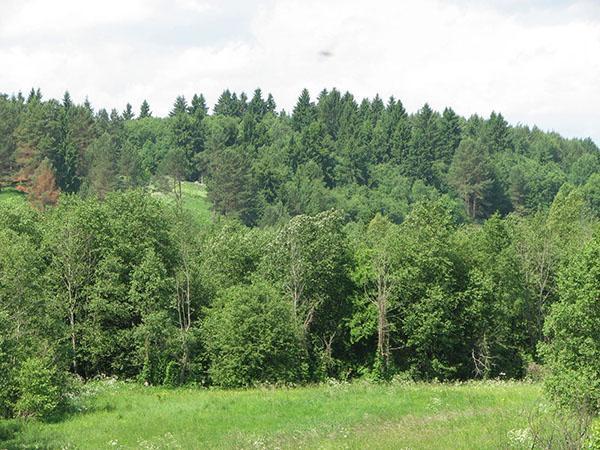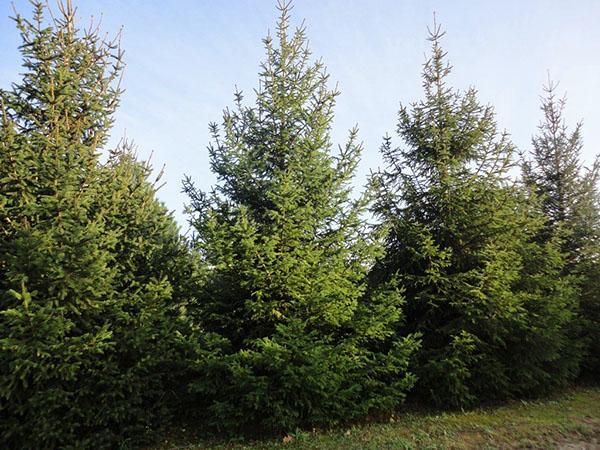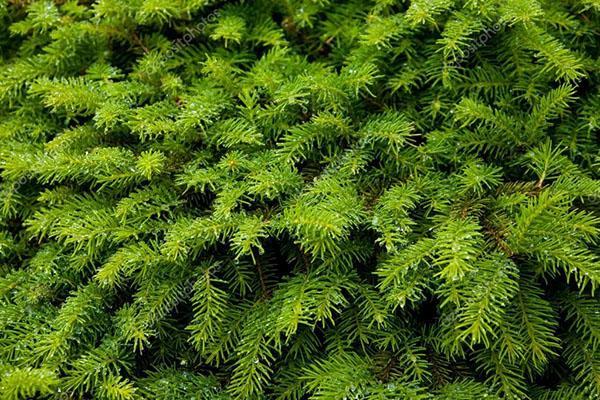Delight in the shade of an evergreen spruce
 Every person at least once in his life thought about the beauty of the nature around us. Evergreen cedars and spruces, powerful oaks, slender poplars and lovely birches amaze with their splendor.
Every person at least once in his life thought about the beauty of the nature around us. Evergreen cedars and spruces, powerful oaks, slender poplars and lovely birches amaze with their splendor.
And how pleasant it is to spend time in the coniferous forest, enjoying the unique aroma? In order to experience such pleasure as often as possible, many people plant an evergreen beauty spruce in their personal plot.
Why is this tree so attractive? Its appearance, useful properties, as well as ease of care.
General characteristics of an evergreen tree

Spruces are slender trees, growing from 35 m to 50 m. During the first 10 years they grow very slowly and only in height. For a year - only a few centimeters. During this period, a taproot is formed in the tree, which is firmly fixed in the soil. After 15 years, the superficial part of the root system begins to develop. Thanks to this, the growth of spruce accelerates up to 120 years of age, and then slows down again.
The tree has a crown that resembles a pyramid with a pointed top. Throughout the trunk, almost perpendicular to it, there are dense branches. The trunk of a young spruce is colored gray-brown. Older trees are distinguished by a gray bark, which flakes off in small plates.
 Tetrahedral or flat needles grow in a spiral on the branches. Its viability lasts for 6 years. The one that falls off is regularly updated. The color of the needles happens:
Tetrahedral or flat needles grow in a spiral on the branches. Its viability lasts for 6 years. The one that falls off is regularly updated. The color of the needles happens:
- green;
- blue;
- yellowish;
- bluish gray.
 In addition, the needles glamorously shine, albeit very sharp. Despite this, the prickly spruce shown in the photo evokes awe.
In addition, the needles glamorously shine, albeit very sharp. Despite this, the prickly spruce shown in the photo evokes awe.
Like any tree, spruce blossoms and bears fruit. Usually these are cones of a cylindrical, slightly pointed shape. They grow up to 15 cm in length and consist of small scales with seeds hidden inside.
In the middle of autumn, they ripen and are carried away by gusts of wind in different directions. Each seed does not lose its germination for 10 years, so it is not known when and where a new tree will appear.
For the successful growth of an evergreen beauty, suitable conditions are necessary. Namely:
- Shady area.
- Moderate moisture.
- Suitable climate.
- Loose soil.
Usually the tree is not afraid of cold weather, but too hot and prolonged summer can harm it. Therefore, growing spruce in your country house, you should take into account the climate.
If young trees are planted in an open area, they can suffer from sunburn. Ateers need moderate watering and are afraid of drought.
In the natural environment, there are about 50 species of evergreen beauty. Many of them grow in their natural environment. Others are considered decorative, therefore they are grown in urban areas and in summer cottages.
Popular types of spruce in nature
Since evergreen spruces have a different crown shape and color of needles, they are divided into different types. Let's get acquainted with the most popular varieties.
Common European spruce
 An evergreen beauty of this species reaches 30 m in height. Sometimes there are real giants - about 50 meters. The crown of European spruce is cone-shaped, it can be about 8 meters in diameter. Most often it is dense with a pointed top.
An evergreen beauty of this species reaches 30 m in height. Sometimes there are real giants - about 50 meters. The crown of European spruce is cone-shaped, it can be about 8 meters in diameter. Most often it is dense with a pointed top.
The branches are located on the trunk in a drooping or prostrate form. The bark is smooth, dark gray. In adulthood, it becomes reddish and flakes off in thin plates, which is considered a natural process.
European spruce is characterized by needle-shaped needles, tough and prickly to the touch. It has a four-sided shape with a sharp tip. Color - dark green with a shiny tint. On the branches, the needles remain for about 12 years, after which they crumble and are replaced with a new one.
 It begins to bloom in late spring or early summer. Male reddish inflorescences and female green spikelets appear on the branches. Fruits are cylindrical cones 15 cm long. When unripe, they are colored green or purple, when ripe, they take on a reddish tint.
It begins to bloom in late spring or early summer. Male reddish inflorescences and female green spikelets appear on the branches. Fruits are cylindrical cones 15 cm long. When unripe, they are colored green or purple, when ripe, they take on a reddish tint.
To understand how fast the common spruce grows, you can watch it. For the first 10 years, a young tree practically sits in place. But this is only at first glance, it is just that the spruce grows very slowly at first. But then the growth accelerates. Each year the trunk grows 50 cm high and 15 cm wide. If you endure the first 10 years, you will receive a majestic green beauty as a reward.
In addition, there are many decorative species of common spruce.
Acrocona
 The tree grows up to 3 m in height. The crown width reaches 4 m. The shape is a wide cone. The branches are semi-lowered, on which the tetrahedral, needle-shaped needles grow. It is usually dark green in color with a shiny sheen.
The tree grows up to 3 m in height. The crown width reaches 4 m. The shape is a wide cone. The branches are semi-lowered, on which the tetrahedral, needle-shaped needles grow. It is usually dark green in color with a shiny sheen.
A young tree has a gray and smooth bark. Later it becomes reddish or brown in color, acquiring roughness.
During the year, the spruce grows 10 cm in height and 8 cm in width. It blooms in May. Pinkish bumps appear first. When ripe, they acquire a red tint.
This variety of spruce is considered frost-resistant and shade-tolerant.
Aurea
 This type of spruce can grow up to 10 m in height. Its unique beauty is reflected in the shiny yellowish-white needles. For this it is called golden.
This type of spruce can grow up to 10 m in height. Its unique beauty is reflected in the shiny yellowish-white needles. For this it is called golden.
If the tree grows in an open area, it can be damaged by sunlight. In the shade, golden needles lose their unique shade. It grows up to 12 cm per year.
Will Zwerg
 A short evergreen beauty grows only up to 2 meters. The crown diameter reaches 80 cm. At a young age, the tree has a smooth brownish bark. With age, the trunk acquires a reddish tint and roughness.
A short evergreen beauty grows only up to 2 meters. The crown diameter reaches 80 cm. At a young age, the tree has a smooth brownish bark. With age, the trunk acquires a reddish tint and roughness.
The needles are of a tetrahedral configuration, reminiscent of long needles. On a young seedling it is light green, on an adult it is in a dark tone. Usually grows slowly.
Dwarf spruce Will Zwerg loves shaded areas, so when choosing a planting site, this fact should be taken into account. Otherwise, the tree may suffer from sunburn.
Nidiformis
 The unique decorative spruce of this kind resembles a large nest. Her crown is rounded. Sometimes it is flat, but it always looks neat and compact. Diameter - 2.5 meters.
The unique decorative spruce of this kind resembles a large nest. Her crown is rounded. Sometimes it is flat, but it always looks neat and compact. Diameter - 2.5 meters.
It grows generally up to 1.2 m in height. The annual growth rate is 5 cm. The needles are bright green, short and tough.
Nidiformis perfectly tolerates shadow. Does not like stagnant water. Frost resistant. It is often used to decorate the garden space.
Choosing spruce in the nursery for your garden - video
Spruce prickly
 Thorny spruce is also widespread in nature. It is found in the picturesque valleys of mountain rivers or streams in Canada and the United States. The tree belongs to the Pine family. It grows up to 30 meters, while the trunk can be 1.5 m in diameter. A truly majestic beauty!
Thorny spruce is also widespread in nature. It is found in the picturesque valleys of mountain rivers or streams in Canada and the United States. The tree belongs to the Pine family. It grows up to 30 meters, while the trunk can be 1.5 m in diameter. A truly majestic beauty!
The needles of prickly spruce are of various shades. The color ranges from bluish green to bluish tints. The buds are reddish at first and light brown when ripe. Length - from 5 to 10 cm.
The prickly spruce is considered an old-timer. Its life span reaches 600 years. For its unusual beauty, it has become a symbol of the American state of Colorado.
The name "Thorny spruce" applies only to wild trees. Varietal varieties are called Glauka.
Such an evergreen beauty loves a lot of light, although she feels great in the shade. Cultural options take root well in city parks and summer cottages. In this photo - prickly spruce Glauka is shown in all its beauty and grandeur.
 There are many decorative varieties derived from the prickly beauty. Each of them has its own characteristics that I would like to draw attention to.
There are many decorative varieties derived from the prickly beauty. Each of them has its own characteristics that I would like to draw attention to.
Evergreen trees with blue or grayish needles are especially impressive. They are distinguished by a conical crown, on which cones are evenly scattered. They live in their natural environment for over 600 years. Those that grow on personal plots live up to 100 years.
To date, breeders have bred over 70 species of blue spruce. The Glauka spruce shown in the photo is one of the examples of human creativity.
 The decorative types include not only the classic versions of blue spruces, but also undersized specimens. Some of them resemble evergreen shrubs with a fluffy crown. They grow up to 1.5 meters in height.
The decorative types include not only the classic versions of blue spruces, but also undersized specimens. Some of them resemble evergreen shrubs with a fluffy crown. They grow up to 1.5 meters in height.
Almost all decorative varieties of prickly spruce are frost-resistant and can easily withstand air temperatures down to -35 ° C. Let's consider some popular varieties.
Blue dwarf spruce
 Most often, this type of spruce is used to decorate summer cottages and garden paths. Since the tree grows no taller than 2 m, its branches will not hang overhead. They grow slowly - 3 or 5 cm per year.
Most often, this type of spruce is used to decorate summer cottages and garden paths. Since the tree grows no taller than 2 m, its branches will not hang overhead. They grow slowly - 3 or 5 cm per year.
Spruce is not afraid of shaded areas, therefore, in such conditions, it does not require special care. It is enough to regularly observe the plant and, if necessary, treat it with chemicals from parasites. Blue dwarf spruce propagates mainly with the help of cuttings. Thanks to this, it is not difficult to breed it at home.
Blue beauty Oldenburg
 The name of the variety indicates that the tree was bred in Germany. It grows up to 15 m in height, with an annual growth rate of 35 cm. The spruce has a conical crown, the diameter of which can reach 7 meters.
The name of the variety indicates that the tree was bred in Germany. It grows up to 15 m in height, with an annual growth rate of 35 cm. The spruce has a conical crown, the diameter of which can reach 7 meters.
The needles are blue, but tough to the touch. Loves fertile soil and spacious areas. It is used as a decorative tree in parks or summer cottages.
Spruce blue Glauka
 It is interesting that this type of evergreen beauty is of two varieties:
It is interesting that this type of evergreen beauty is of two varieties:
- classic;
- dwarf.
The classic version of the tree grows up to 25 meters. It is used for coniferous plantings outside the city. In addition, the classic blue glauca spruce perfectly emphasizes the architecture of many administrative buildings. The dwarf version of the blue spruce reaches no more than 2 m in height. The growth rate is 10 cm per year.
To propagate this type of spruce, the best seedlings grown from seeds are selected. Often the tree is planted by grafting. Proper planting and care of Glauka spruce helps to get a beautiful tree.
It is better to plant such a spruce in the spring on moist loamy soil. So she can strengthen and prepare for the winter. During the warm season, the tree is fed with specialized fertilizers.
For planting dwarf blue spruce, do not use completely shaded areas. Too wet soil can lead to stem rot.
Regular fluffing of the soil near the roots of the tree promotes rapid growth. The main thing is to do it carefully so as not to damage the root system.
If a reddish tint appears on the needles, it means that the tree has been affected by a fungus. Special chemicals will help protect the spruce from diseases.
On hot summer days, 12 liters of water for a week is enough for young seedlings. However, it should not be too cold.
As you can see, planting and caring for a dwarf species of spruce is quite simple.
 Many gardeners are attracted by the dwarf spruce Glauka Globoza. At first, the tree has a spherical crown that is slightly flattened. After 15 years, the main shoot appears, giving it a triangular shape. In this photo, the Glauka Globoza spruce resembles an original blue ball that can decorate any summer cottage.
Many gardeners are attracted by the dwarf spruce Glauka Globoza. At first, the tree has a spherical crown that is slightly flattened. After 15 years, the main shoot appears, giving it a triangular shape. In this photo, the Glauka Globoza spruce resembles an original blue ball that can decorate any summer cottage.
Unlike deciduous trees, evergreen beauties never leave their pedestal. They make the backyard landscape unique all year round. Why not plant a blue spruce tree for true nature enjoyment? Many have been contemplating this beauty for a long time.